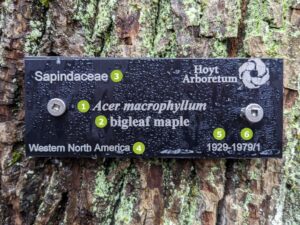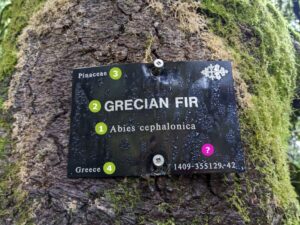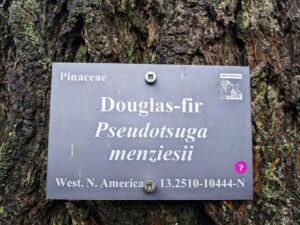In 2023, Hoyt Arboretum Friends Visitor Center volunteers and trail rovers welcomed more than 40,000 visitors, and our Nature Educators interacted with 5,400 children. This is just a small faction of all the folks who came to explore and learn from our global tree collection!
Museum of Living Trees
Beyond the people Hoyt Arboretum Friends engages with directly, Portland’s museum of living trees has a unique opportunity for public education. On a walk through Hoyt Arboretum anyone can look at a tree’s sign and learn what species it is, its family, its geographic origin, and when it was planted (if it was planted at all!). Many of the 6,000+ trees at Hoyt Arboretum proffer this information, but we also know there’s a bit of a trick to decoding each type of sign!
A Brief History of Tree Signs
Over the (almost) 100 years since Hoyt Arboretum was established in 1928, there have been different methods of recording trees in the collections. As such, you might see a handful of different kinds of tree signs along the trails.
Here’s your guide on how to read the most common tree signs at Hoyt Arboretum.
The Newest Version
The most up-to-date version of a Hoyt Arboretum tree sign looks like this, and has 6 main pieces of information.


- Latin or scientific name: the one true name for the species known the world over.
- Common name: the one most commonly used here in the PNW, though we know there are a frustrating number of common names used to describe a single species.
- Taxonomic family: describes what other trees the species is related to. This bigleaf maple is in the Sapindaceae family which includes all maples along with chestnuts, lychees and others.
- Geographic origin: where the tree is native to.
- Year planted: this bigleaf maple was planted in 1929.
- Accession number: a number tied to the tree as it is listed in our database.
Older Versions
Some tree signs look a little different. The components numbered 1-4 on the Grecian fir sign share the same information as the most up-to-date version of tree sign, but may appear in a different order.


The numbers in the bottom right corner, labeled with a pink question mark in this picture contain different information.
The first number indicates the closest “marker post”, or location marker that is unique and specific to the Arboretum.
The second number indicates the tree’s “azimuth” or the angular distance from that marker post. A lot of work is being done currently to verify these azimuth readings, and according to our 2023 Collections Intern Rowan, “this number is often off, or measured in inconsistent units-sometimes in feet, sometimes in meters. Using accession numbers tied to our database is a far more reliable method.”
The third number indicates the last 2 digits of the year the tree was planted. In this case, the Grecian fir was planted in 1942.
Other Peculiarities
Much like the previous sign, this Douglas-fir sign is in the same style and conveys the same information, but you might notice that instead of a number indicating the year it was planted, there is an “N”.


This indicates that the Douglas-fir is native and was either not planted or was planted before the Arboretum was established in 1928.
The Future of Tree Signs at Hoyt Arboretum
With member support, Hoyt Arboretum Friends will continue to cover the costs of updating and maintaining tree signs at the Arboretum. We envision a future where we have a consistent, standardized system for labelling trees that is accurate and useful to staff, community partners, and the public. Become a member.


